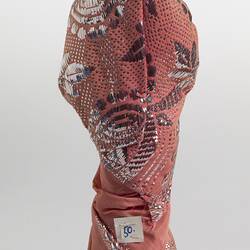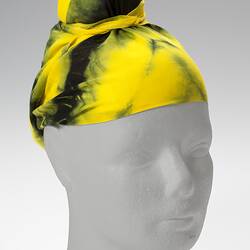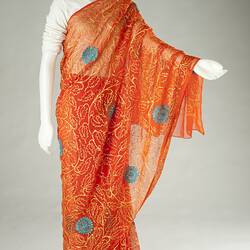Summary
National Doll produced to represent an Indian woman. Dolls are among the most universal toys found throughout the world and through history. Ornamental dolls can also be used to represent aspects of cultural traditions, such as dress.
The doll is wearing a sari or saree, which is a strip of unstitched cloth, ranging from four to nine metres in length that is draped over the body in various styles. It is popular in India, Nepal, Bangladesh, Pakistan, Sri Lanka, Bhutan, Burma, and Malaysia. The most common style is for the sari to be wrapped around the waist, with one end then draped over the shoulder baring the midriff.
This doll comes from a collection of approximately 150 dolls in an array of national and regional costumes which were collected by Edna Setford from 1964-1988. Her husband Clifford continued the collection until his death in 1997. The collection is the work of both Edna and Clifford as well as many friends and family who brought dolls home to Edna as gifts from overseas trips. The final doll arrived two days after Clifford's death.
These dolls were purchased as souvenirs of particular countries and like many mass produced souvenirs they are often not accurate representations of a particular country or region, and may actually better reflect neighbouring counties or regions. This occurs because costumes are often stylised and simplified resulting dolls wearing generic costume elements which are common to many countries/regions. Often the fabrics and decorations used are selected to make the dolls cheap and easy to manufacture and aesthetically pleasing. This can result in the fabrics, colours and decorations of the doll's clothing having little or no reflection of the costume associated with a particular country or region for whom they are meant to represent.
Physical Description
Female doll dressed in a light pink sari, with a pink and silver head covering. The doll's arms are made from light brown fabric and its face has been painted in a similar shade, with bright red lips, dark eyes and a and a red tilaka or bind on the forehead. The doll wears blue and gold bracelets on both wrists, a tick gold chain around her neck and carries a light pink handbag.
More Information
-
Collecting Areas
-
Acquisition Information
Donation from Eril Wangerek, 01 Sep 1997
-
User
Mr & Mrs Edna & Clifford Setford, Victoria, Australia, circa 1964-1997
Owners of this doll collection which was acquired during this period. -
Place Depicted
India
This doll is dressed to represent an Indian woman -
Classification
-
Category
-
Discipline
-
Type of item
-
Dimensions
110 mm (Width), 245 mm (Height)
-
Keywords
Indian Costumes, Keepsakes, National Costumes, Souvenirs, Travel, Women's Clothing





